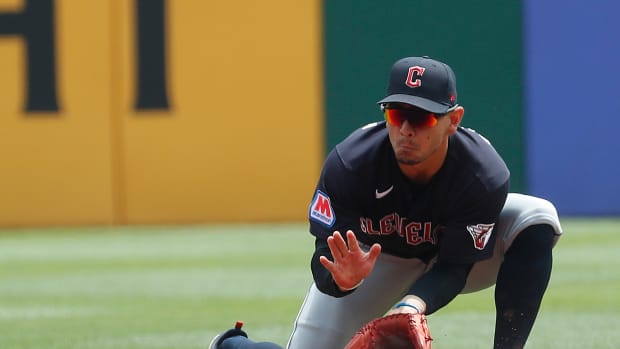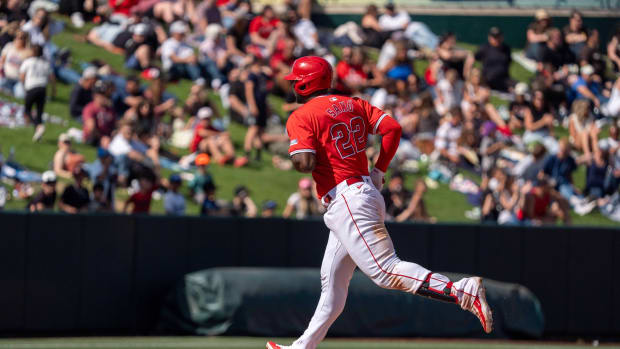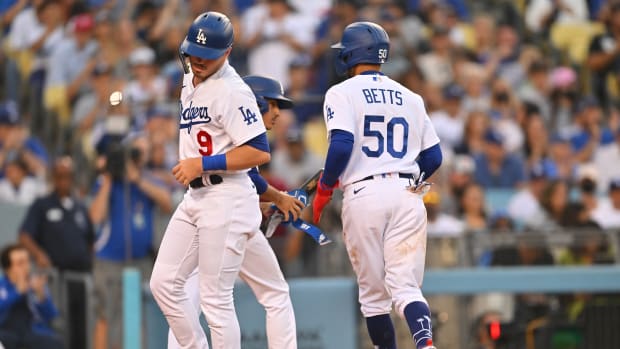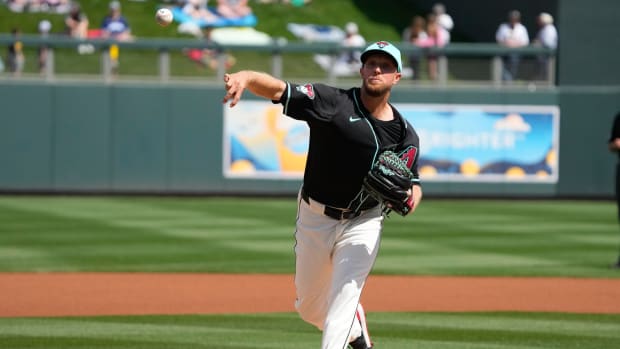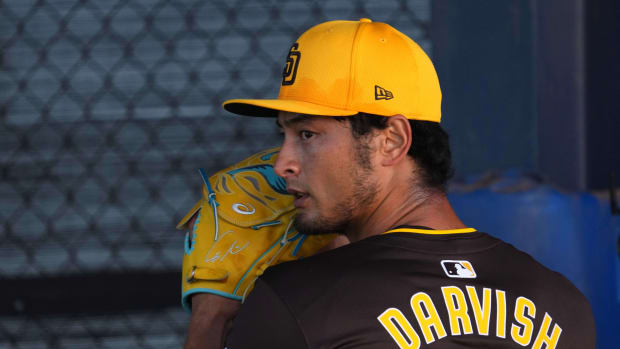My 2018 Virtual Hall of Fame Ballot
The following article is part of my ongoing look at the candidates on the BBWAA 2018 Hall of Fame ballot. For a detailed introduction to this year's ballot, please see here. For an introduction to JAWS, see here.
Cue the annualrefrain, for it remains true: There's no such thing as a perfect Hall of Fame ballot. Even with the BBWAA electing 12 players over the past four years—a bounty of honorees unseen since 1936–39, the Hall's first four elections—the ballot still has a backlog of plausible candidates, more than will fit within a voter's 10 allotted spots.
In an ideal world, a voter can fill out his or her ballot entirely according to merit, selecting every candidate who meets the Hall of Fame standards by his or her own reckoning. This is the so-called "binary ballot," to use the term of the St. Louis Post-Dispatch's Derrick Goold (a past president of the BBBWAA). In reality, any voter who identifies more than 10 candidates worthy of the honor is required to perform a kind of triage—selecting his or her top 10 candidates, hoping that the traffic abates enough to allow consideration of those who just missed the cut next year and weighing some tough questions. Beyond simply worrying that they'll catch hell from the public for supporting Player X or will miss an opportunity to support the low-polling Player Y, voters have to deal with thorny issues such as candidates linked to performance-enhancing drugs and the (mis)application of the so-called "character clause."
More than 10 candidates at a time worthy of the game's highest honor? Study the history of the Hall of Fame and its denizens and you'll quickly be reminded that they can't all be Willie Mays. While voting for everyone better than Bad Choice Player Q based on a lowest common denominator standard isn't the right answer, the writers and the institution have failed to keep pace in terms of electing modern players, not just those who played in the 1990s and 2000s, but further back as well. Limiting the field to those elected by the BBWAA, and calling upon research I compiled for The Cooperstown Casebook, here's a breakdown of the average number of Hall of Famers per team per season for select periods:
Period | HOF/Team/Year |
1925–1941 | 1.54 |
1946–1968 | 1.39 |
1969–1992 | 1.31 |
1993–2003 | 0.71 |
I've omitted the World War II years, when several future Hall of Famers entered the service, and placed other cutoffs right at the point of two rounds of expansion (from 20 teams to 24 in 1969, and from 26 to 28 in 1993). The level of representation has been below 1.0 every year since 1994, and no higher than 0.6 since 1999. Future elections will push those numbers higher; seven candidates active in 1994 have received at least 50% of the vote already, strongly suggesting future election, and two first-timers appear to be locks, but even if the writers tab all of them before they fall off the ballot, that year’s rate would only rise to 1.29 (36 Hall of Famers on 28 teams), suggesting the absence of at least a few others; rates of 1.4 or 1.5 per team would suggest 39 or 42 Hall of Famers active in that season, meaning that we’re currently short about 12–15.
Some of the current shortfall, and thus the ballot's backlog, owes to the split in the electorate regarding the handing of candidates linked to PEDs. with the Hall's ham-fisted attempts to interject, from their unilateral 2014 decision to truncate the eligibility window from 15 years to 10, to this year's plea from vice chairman Joe Morgan, only exacerbating the problem.
Despite the work I put into my annual series and into Hall of Fame research in general, I do not yet have a ballot of my own. Under BBWAA rules, I am three years away from that privilege. Nonetheless, every year I create my virtual ballot to illustrate the hard choices a voter faces, and do so by the ballot submission deadline (December 31). As always, I am guided by my JAWS system, but not enslaved by it. There are considerations that a Wins Above Replacement-based methodology—which can account for the widespread variations in scoring from era to era and ballpark to ballpark (producing the occasional double-take)—can't capture, including pennant race and postseason contributions, awards and honors, and historical importance.
It's time to fish or cut bait. Of the 33 candidates on this year's ballot, six exceed their positions’ career WAR, peak WAR and JAWS standards across the board, and another four do so via career WAR and JAWS but not peak. Two other candidates exceed the standard on peak alone. Beyond that are a trio of "candidates of interest," players who fall shy on JAWS but about whom I remain open-minded, for reasons explained below. That leaves 15 players for the first-cut list, with those that exceed the standards in bold:
Player | Years on Ballot | Career WAR | Peak WAR | JAWS | Margin |
Barry Bonds | 6 | 162.4 | 72.7 | 117.6 | 64.3 |
Roger Clemens | 6 | 140.3 | 66.3 | 103.3 | 41.2 |
Chipper Jones | 1 | 85.0 | 46.6 | 65.8 | 10.6 |
Jim Thome | 1 | 72.9 | 41.5 | 57.2 | 2.6 |
Curt Schilling | 6 | 79.9 | 49.0 | 64.5 | 2.4 |
Mike Mussina | 5 | 83.0 | 44.5 | 63.8 | 1.7 |
Scott Rolen | 1 | 70.0 | 43.5 | 56.8 | 1.6 |
Manny Ramirez | 2 | 69.2 | 39.9 | 54.6 | 1.3 |
Edgar Martinez | 9 | 68.3 | 43.6 | 56.0 | 0.8 |
Larry Walker | 8 | 72,6 | 44.6 | 58.6 | 0.5 |
Andruw Jones | 1 | 62.8 | 46.4 | 54.6 | -3.3 |
Sammy Sosa | 6 | 58.4 | 43.7 | 51.0 | -7.1 |
Vladimir Guerrero | 2 | 59.3 | 41.1 | 50.2 | -7.9 |
Trevor Hoffman | 3 | 28.4 | 19.6 | 24.0 | -10.4 |
Billy Wagner | 3 | 28.1 | 19.9 | 24.0 | -10.4 |
The last column is the margin by which each player exceeds or falls short of the JAWS standard at his position. For space considerations, I'm not going to rehash why I have no Jeff Kent, Fred McGriff, Gary Sheffield, or Omar Vizquel here; you can read their cases elsewhere.
As I've said repeatedly throughout this series, when it comes to considering players connected to PEDs, I draw a line between those whose allegations date to the time when the game had no testing regimen or means of punishment (i.e., prior to 2004) and those that came afterwards. With no means of enforcing a paper ban, and with players flouting such a ban being rewarded left and right amid what was truly a complete institutional failure that implicated owners, the commissioner and the players' union as well as the players, I simply don't think voters can apply a retroactive morality to say that a Bonds or a Clemens or a Sosa shouldn't be in the Hall on that basis alone. I've done enough research to believe that this is a reasonable place to start, but it must be acknowledged that there's no consensus within the electorate over how to handle the issue, and voters' views on the topic range from "performance only" to "hang 'em high at the first hint of suspicion."
Thus, two spots on my ballot go to Bonds, the all-time home run leader, and Clemens, the best pitcher since World War II. As noted within my profiles of the gruesome twosome, last year's election of commissioner Bud Selig sparked reconsideration from much of the electorate, such that the pair surpassed the 50% mark in the voting for the first time. The Morgan letter doesn't appear to have stopped their momentum; both are polling at 73.3% through the 127 public ballots shared at the @NotMrTibbs Ballot Tracker. They won't be elected this year, but with three years of eligibility remaining, their eventual election appears likely. Flee to the Pro Football Hall of Fame, where everyone is as pure as the driven snow, if you must.
Also easily making the cut, listed in order of the aforementioned margin, with my lightning-round summaries of their cases, and links to their full profiles:
• Chipper Jones (sixth among third basemen in JAWS): The offensive cornerstone of the Braves' long NL East dynasty mashed 452 home runs, collected 2,726 hits, made eight All-Star teams and won an MVP award. He's the only switch hitter to top a .300 batting average, .400 on-base percentage and .500 slugging percentage in at least 7,000 PA.
• Thome (10th among first basemen in JAWS): A slugger with a tremendous uppercut, he's eighth all-time in homers (612) and seventh in walks (1,747). At the 7,000 PA cutoff, his .554 slugging percentage ranks 19th, his .402 on-base percentage 28th, and his 147 OPS+ tied for 30th with Hall of Famers Willie McCovery, Mike Schmidt, Willie Stargell and ballot-mate Edgar Martinez.
• Schilling (27th among starters in JAWS, 45.0% in 2017): The best postseason pitcher of his generation, and the owner of an outstanding strikeout rate and the best strikeout-to-walk ratio since the pitching distance moved to 60-foot-6. Contrary to his conspiracy theory, he was trending towards election in spite of his abrasive public persona and political views until his 2016 pro-lynching tweet stopped his momentum, costing him 7.3 percentage points relative to the previous cycle.
His post-career comments are objectionable, but they had no bearing on his playing career. I believe it’s a misapplication of the character clause to connect Schilling’s words to the “integrity, sportsmanship, character” portion of the Hall’s voting instructions, but I can understand if voters feel that he’s crossed a line.
• Mussina (28th among starters in JAWS, 51.8% in 2017): Despite his lack of a Cy Young, championship ring or major milestone (300 wins or 3,000 strikeouts), his long-term success at run prevention and his outstanding strikeout rate and strikeout-to-walk ratio make him eminently worthy of Cooperstown. With back-to-back years of big gains that have more than doubled his support, it's clear that voters are finally coming around to that conclusion.
• Rolen (10th among third basemen in JAWS): An exceptional but underappreciated two-way player, Rolen combined power and patience at the plate with some of the best glove work the hot corner has ever seen. Even in a career that contained numerous injuries and ended at age 37, he ranks third at position both in fielding runs (+175) and in Gold Gloves (eight) and, depending upon your choice of metric, belongs among the top 10 or 20 hitters for the position as well. Particularly at an underrepresented spot—there are just 13 third basemen in the Hall, compared to 24 rightfielders and 19 to 21 at every other position besides catcher—he merits enshrinement. He’s currently hovering at 9.9% among the published ballots; one can only hope he survives this cycle so that more voters can review what they've missed the first time around.
• Martinez (11th among third basemen in JAWS, 58.6% in 2017): With apologies to David Ortiz, Martinez is not just the best designated hitter of all time but one of the best hitters ever, ranking 14th in OBP and 30th in OPS+ (7,000 PA minimum), with 500-plus average-ish games at 3B bolstering his value. As of 2015, his candidacy looked like a lost cause, with just 27.0% of the vote and his remaining time on the ballot having shrunk from nine years to four. His level of support has more than doubled in the past two cycles, and it now looks as though he'll complete a Tim Raines-like ascension to Cooperstown next year, if not this one.
• Walker (10th among rightfielders in JAWS, 21.9% in 2017): A legitimate five-tool player, Walker was outstanding at defense and base running as well as hitting. Even after adjusting for the time he spent in a high altitude hitters’ paradise, he's tied for 43rd all-time in OPS+. His injury-shortened career has provoked some resistance among voters, but many have come around; 19 of the 127 ballots published so far have included him for the first time, offering hope for late-candidacy surge.
That's nine spots I’ve filled, with the other six candidates vying for the 10th — not that I'm obligated to use that spot, but as I can see plausible cases for all of these guys, I’m determined to pick one. Again to the lightning round:
• Ramirez (10th among leftfielders in JAWS, 23.8% in 2017). On the basis of performance only—or, for that matter, sheer entertainment value—he'd get my vote, but for all of my conviction that he's one of the greatest hitters of all time (his 154 OPS+ ranks 20th) I can't get past the two failed tests, not when better players who never tested positive are being kept out over more nebulous PED allegations.
• Andruw Jones (11th among centerfielders in JAWS). If Chipper was the Braves dynasty's offensive cornerstone, Jones was its defensive one, an elite fly-chaser who won 10 Gold Gloves and ranks first in fielding runs at the position (+236). He could hit, too, bopping 434 career homers. His career collapsed at age 31, however; he played just 435 games over his final five seasons, disappearing from the majors at age 35, and so while he's solidly above the peak standard, he's short on the career and JAWS ones. I'm not so bothered by that, given his relative ranking and the fact that the standards at centerfield and rightfield are a few points higher than every other position.
• Sosa (18th among rightfielders in JAWS, 8.6% in 2017): A towering figure in baseball's return from the strike, and just the sixth player to reach 600 home runs, he's nonetheless below the bar in JAWS. That matters more to me than the report that he was on the supposedly anonymous 2003 survey test, which commissioner Rob Manfred basically disavowed in the context of celebrating Ortiz, on the grounds that some disputed results were never resolved because the threshold to implement testing had been reached. That doesn't mean Sosa was clean, but if MLB couldn't penalize him, I'm not going to.
• Guerrero (21st among rightfielders in JAWS, 71.7% in 2017): A spectacularly unrefined five-tool player, he's much stronger on the traditional merits — no eligible hitter with a lifetime average of .318 in at least 7,000 PA is outside the Hall — than in JAWS, where he's surprisingly short due in part to modest value outside the batter's box.
• Hoffman and Wagner (tied for 20th among relievers in JAWS, 74.0% for Hoffman and 10.2% for Wagner in 2017). The former once held the all-time record for saves, the latter still does for strikeout rate and opponent batting average, albeit at just an 800-inning threshold. Neither measures up to the admittedly slapdash JAWS standard established by the five enshrined relievers, who all spent some time as starters and threw significantly more innings than this pair in their careers. Nor do they measure up to Mariano Rivera, the best reliever of his era and a sure bet for first-ballot election in 2019. But since I've never been entirely satisfied with how JAWS handles relievers, I've remained open-minded on this pair, seeking alternate ways to evaluate them using advanced stats, namely Win Probability Added (WPA) and situational or context-neutral wins (WPA/LI), both of which paint them in a better light than WAR. When I combine those with career WAR, averaging the three stats, I get this:
Rank | Player | WAR | WPA | WPA/LI | Avg |
1 | Mariano Rivera | 56.6 | 56.6 | 33.7 | 48.9 |
2 | Dennis Eckersley | 62.5 | 30.8 | 25.8 | 39.7 |
3 | Hoyt Wilhelm | 50.1 | 31.3 | 27.0 | 36.1 |
4 | Rich Gossage | 41.8 | 32.5 | 14.9 | 29.7 |
5 | Trevor Hoffman | 28.0 | 34.1 | 19.3 | 27.1 |
6 | Billy Wagner | 27.7 | 29.0 | 17.9 | 24.9 |
12 | Lee Smith | 29.4 | 21.3 | 12.9 | 21.2 |
16 | Rollie Fingers | 25.0 | 16.2 | 15.2 | 18.8 |
18 | Bruce Sutter | 24.5 | 18.2 | 11.9 | 18.2 |
| Hall avg w/ Eckersley | 40.8 | 25.8 | 18.9 | 28.5 |
| Hall avg w/o Eckersley | 35.4 | 24.6 | 17.3 | 25.7 |
While I've had a hard time disconnecting the two, and remain more impressed by Wagner's sheer dominance, that suite of stats shows some separation. If I'm choosing a reliever on merit—that's still if—it should be Hoffman, who filled my 10th spot last year. On the other hand, if I’m voting tactically, to ensure that a candidate survives the current swell of traffic to maintain the 5% necessary to remain on the ballot, Wagner (10.7% on the ballots published), can’t be ruled out.
From the remaining group, Ramirez's positive tests make him an easy cut, as do the JAWS shortfalls of both Sosa and Guerrero. Don't get me wrong, I'm happy that the latter will be elected this year, even without my help, because he was an electrifying player whom I loved to watch. His candidacy can live without the JAWS stamp of approval.
Thus my choice comes down to Hoffman, Wagner and Jones, and while Andruw’s career length is an issue in some contexts, it can't be called "too short" when measured next to pitchers with fewer than 1,100 career innings. Besides, Hoffman's election is an inevitability, given that he fell just five votes short last year, whereas Jones—who's currently polling at 6.1%—may well go the way of 2013 candidate Kenny Lofton (ninth in JAWS among centerfielder), falling off the ballot. If I can't offer him full support in the form of a vote, the least I can do is give him my virtual support.
So that's my 10: Bonds, Clemens, Andruw, Chipper, Thome, Rolen, Martinez, Mussina, Schilling and Walker. Apparently, not a single one of the 127 ballots published at the Tracker has that combo. The most common ballot, accounting for 15 of those cast so far, has Guerrero and Hoffman where I have Andruw and Rolen. Only two ballots have both Andruw and Rolen; both include Hoffman, with Vizquel on one and McGriff on the other.
With that, I’ve wrapped up this year’s series, at least from the standpoint of candidate evaluation—the 15th time I’ve done so using JAWS, and my sixth at SI.com. Given that the election results won’t be announced until January 24, I’m sure to have additional Hall-related content in the coming weeks, but until then, thank you, readers, for following along in 2017, and best wishes for a happy and healthy '18 even if we disagree on our ballots.

































